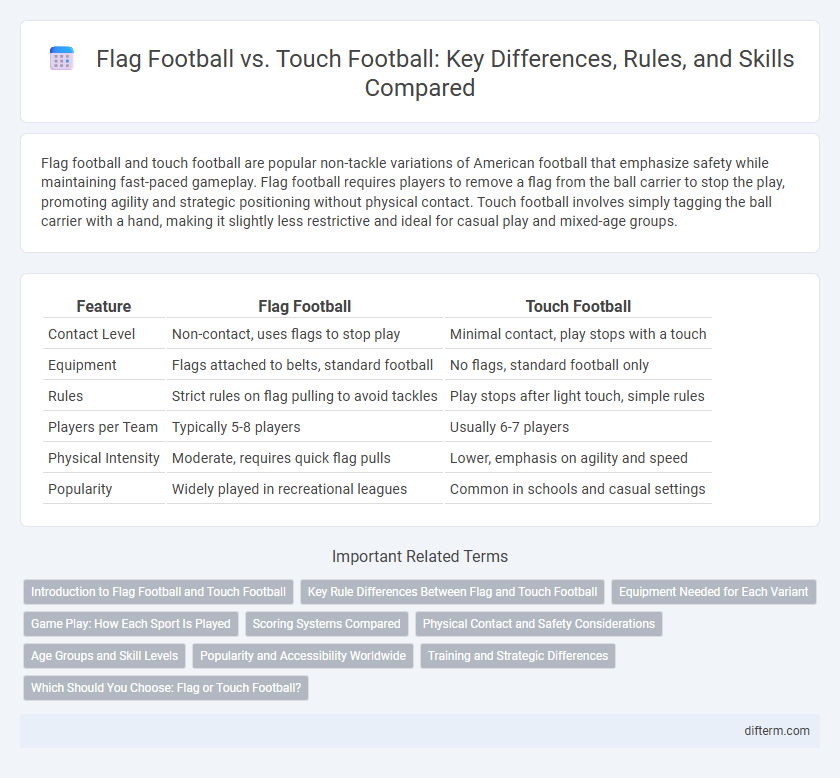Flag football and touch football are popular non-tackle variations of American football that emphasize safety while maintaining fast-paced gameplay. Flag football requires players to remove a flag from the ball carrier to stop the play, promoting agility and strategic positioning without physical contact. Touch football involves simply tagging the ball carrier with a hand, making it slightly less restrictive and ideal for casual play and mixed-age groups.
Table of Comparison
| Feature | Flag Football | Touch Football |
|---|---|---|
| Contact Level | Non-contact, uses flags to stop play | Minimal contact, play stops with a touch |
| Equipment | Flags attached to belts, standard football | No flags, standard football only |
| Rules | Strict rules on flag pulling to avoid tackles | Play stops after light touch, simple rules |
| Players per Team | Typically 5-8 players | Usually 6-7 players |
| Physical Intensity | Moderate, requires quick flag pulls | Lower, emphasis on agility and speed |
| Popularity | Widely played in recreational leagues | Common in schools and casual settings |
Introduction to Flag Football and Touch Football
Flag football and touch football are popular non-tackle variations of American football designed to minimize physical contact while maintaining fast-paced gameplay. Flag football involves players removing a cloth flag attached to the opponent's waist to end a play, emphasizing speed, agility, and precision. Touch football replaces tackling with a simple touch to halt the play, focusing on quick reflexes and strategic movement, making both versions accessible and safe for all ages.
Key Rule Differences Between Flag and Touch Football
Flag football requires players to remove a flag from the ball carrier to indicate a tackle, whereas touch football only requires a single touch with the hand to stop play. In flag football, the removal of the flag results in a play stoppage similar to a tackle in traditional football, while touch football relies on physical contact without flags or pads. The rules for possession and downs are similar in both, but the method of stopping the ball carrier defines the fundamental distinction between the two sports.
Equipment Needed for Each Variant
Flag football requires players to wear flag belts with detachable flags, along with standard athletic attire and cleats for traction on grass or turf surfaces. Touch football, on the other hand, eliminates the need for flags or belts, relying primarily on comfortable sportswear and appropriate footwear for quick movements. Both variants typically use a standard football, but flag football emphasizes equipment that facilitates non-contact play, whereas touch football focuses on agility and minimal gear.
Game Play: How Each Sport Is Played
Flag football involves players wearing flags attached to their belts, with the defense aiming to pull these flags to stop the play instead of tackling. Touch football is played by tagging an opponent with one or two hands to indicate a tackle, emphasizing minimal physical contact and quick gameplay. Both sports prioritize skillful ball handling and strategy, but flag football offers a more structured and safer alternative with specific rules on flag removal.
Scoring Systems Compared
Flag football scoring typically mirrors traditional American football with touchdowns worth six points and extra point attempts available, while touch football often features simplified scoring rules, usually awarding six points per touchdown without additional point-after options. Both games emphasize speed and agility over physical contact, but flag football maintains a closer adherence to standard football scoring conventions. Touch football's streamlined scoring promotes faster gameplay and easier point tracking, making it popular in casual and youth leagues.
Physical Contact and Safety Considerations
Flag football minimizes physical contact by requiring players to remove flags from an opponent's belt rather than tackling, significantly reducing the risk of injuries such as concussions and joint damage. Touch football allows brief physical contact through a touch to stop play, which carries a moderate risk of collisions and minor injuries compared to tackle football. Safety considerations favor flag football for younger or less experienced players due to its lower impact nature and emphasis on agility and speed over physical strength.
Age Groups and Skill Levels
Flag football and touch football cater to different age groups and skill levels, with flag football often preferred for younger children and beginners due to its emphasis on non-contact safety and basic skill development. Touch football accommodates older players and intermediate to advanced skill levels, providing a faster-paced game that hones agility and tactical awareness without full tackles. Both versions support inclusive play but flag football is widely adopted in youth leagues for its structured skill-building approach.
Popularity and Accessibility Worldwide
Flag football enjoys widespread popularity and accessibility worldwide due to its non-contact nature, making it suitable for all ages and skill levels. Touch football also has a strong global presence, particularly in Australia and the United Kingdom, where it is integrated into school and community sports programs. Both variations benefit from minimal equipment requirements, contributing to their growing participation rates across diverse regions.
Training and Strategic Differences
Flag football emphasizes agility and precision in training due to its non-contact nature, requiring players to develop quick hand-eye coordination and accurate flag-pulling skills. Touch football training prioritizes speed and evasive maneuvers, focusing on quick decision-making and spatial awareness to avoid being touched. Strategically, flag football relies on set plays and disciplined route running, while touch football incorporates more dynamic, improvisational offensive strategies to exploit open spaces.
Which Should You Choose: Flag or Touch Football?
Flag football offers a safer alternative to traditional tackle football by using flags to stop play, minimizing physical contact, which appeals to youth and recreational players prioritizing injury prevention. Touch football, while still less intense than tackle football, requires players to physically tag opponents, making it closer to traditional football's dynamics and beneficial for those seeking a more active and strategic game. Choosing between flag and touch football depends on desired intensity, safety preferences, and the level of physical engagement participants are comfortable with.
flag football vs touch football Infographic

 difterm.com
difterm.com